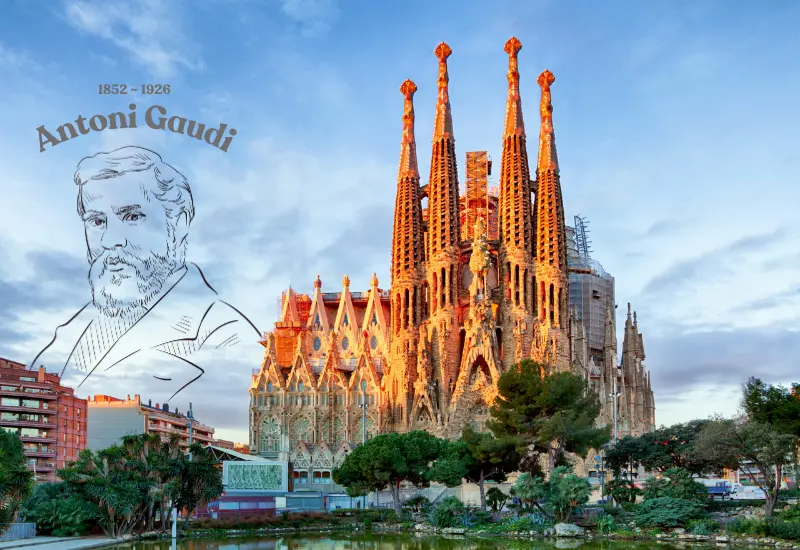Architecture is a vast world, and many architects have entered this field and helped its development over the years. One of the architects who left an immortal name in history is Antoni Gaudi. He was a Spanish architect from Barcelona and a prominent figure in the Modernist architectural movement. His work is world-famous, and most of his designs were inspired by nature. Today, Gaudi’s works attract visitors from all over the world to Barcelona to witness some of the most amazing designs of all time. In the following section, we will explore Antoni Gaudi’s life and artworks to learn more about this great architect and his outstanding creations.
Table of Contents
ToggleAntoni Gaudi Biography
Antoni Gaudi i Cornet was one of the most famous architects in Spain. He was born on June 25, 1852, and after 71 years of life filled with experience and fame, he passed away. His reputation comes from his unique architectural style, which can be seen throughout Barcelona, Spain.
Gaudi was born in the region of Tarragona in Catalonia, Spain. His father, grandfather, and great-grandfather were all coppersmiths. In 1870, he completed his high school education at the Piarist School and then decided to attend the Barcelona School of Architecture.

He had an energetic personality and remarkable talent that helped him progress rapidly. The famous researcher Salvador Tarquey once said about him:
“Antoni always remembered his connection to the coppersmiths and emphasized that his ability to visualize shapes in space and design without the need for detailed drawings came from this background.”
During the last two years of his architectural studies, Gaudi worked on various projects with great architects such as Francisco Del Villar and Joan Martorell. In 1878, he successfully obtained his architecture degree.
He then established an office in Barcelona, and thanks to his exceptional talent, he quickly secured significant projects. One of his first major assignments that same year was designing the layout for the Mataró International Exhibition in Paris.
Antoni Gaudi Architecture
Antoni Gaudi’s architectural style is one of the most distinctive and recognizable in the world. His designs were heavily influenced by nature, incorporating organic forms, flowing curves, and intricate details that mimicked natural elements such as trees, waves, and animals.
Gaudi masterfully combined Gothic and Art Nouveau influences with his own imaginative vision, creating structures that seem almost alive. He avoided rigid lines and preferred dynamic, fluid shapes, often using colorful ceramic tiles, wrought iron, and sculpted stone to bring his creations to life.

His most famous masterpiece, the Sagrada Familia, reflects his deep devotion to both architecture and spirituality, blending innovative engineering with breathtaking artistic expression. Gaudi’s work continues to inspire architects and artists worldwide, making him a true pioneer of modern architecture.
Antoni Gaudi Books
Antoni Gaudi did not write any books himself, but his innovative architectural style and extraordinary works have been the subject of numerous books written by scholars, architects, and historians.
One of the most well-known books about him is Gaudi by Gijs Van Hensbergen, which provides an in-depth look into his life, artistic philosophy, and architectural genius.
Another notable book is The Architecture of Antoni Gaudi by Juan Bassegoda Nonell, which explores his creative process and the technical aspects of his masterpieces.
Many other books analyze his most famous works, including The Sagrada Familia by Mark Burry, which explores the ongoing construction of Gaudi’s iconic basilica. These books help preserve the legacy of Gaudi and offer valuable insights into his visionary approach to architecture.
Antoni Gaudi’s Famous Works
Antoni Gaudi created numerous architectural masterpieces, but some of his works are particularly iconic, unique, and unforgettable. Below are some of his most remarkable creations:
1. Casa Vicens
Casa Vicens was one of Antoni Gaudi’s first major projects, built between 1883 and 1888. He designed this house for a wealthy family that owned a ceramic factory, which is evident in the colorful broken tile mosaics on its façade, known as trencadís.

One of the most fascinating aspects of this building is its inspiration from Islamic architecture, showcasing how Gaudi was far ahead of his time. The latest renovation of the house was completed in 2017, giving it new life, and today, it is open to visitors as a museum.
Address: Carrer de les Carolines, 08012 Barcelona, Spain
2. Sagrada Familia
The famous Sagrada Familia is at the top of Gaudi’s list of works. This masterpiece is not only his most well-known creation but also a perfect representation of the connection between humans, nature, and religion through architecture and sculpture.
Construction of this basilica began in 1892 and is expected to be fully completed by 2030. The church’s interior resembles a puzzle in which Gaudi skillfully merged different styles and innovative techniques. Visitors can also climb one of its towers to enjoy a breathtaking panoramic view of Barcelona.
Address: Carrer de Mallorca, 401, 08013 Barcelona, Spain
3. Casa Batllo
One of Gaudi’s most famous and beloved works is Casa Batllo. This masterpiece was created through a complete renovation of an existing house in 1904. Gaudi used materials commonly associated with Catalan Modernism, also known as Art Nouveau, to transform the structure.
He incorporated elements such as stone, ceramics, and wrought iron to bring his artistic vision to life, making Casa Batlló one of Barcelona’s most admired landmarks.
4. La Pedrera (Casa Milà)
La Pedrera, also known as Casa Mila, is one of Gaudi’s most significant and imaginative works. It is considered one of the most innovative residential buildings in architectural history, not only in Spain but worldwide. The structure appears more like a sculpture than a traditional living space.

In 1984, it was designated a UNESCO World Heritage Site. One of its most stunning features is the combination of wavy stone façades and intricate iron balconies, giving the building a dreamy and surreal appearance.
Address: Provença, 261-265, 08008 Barcelona, Spain
5. Casa Figueres (Bellesguard Tower)
Casa Figueres dates back to 1900 and was built at the request of Gaudi’s friend, Jaume Figueres, as his private residence. This structure, also known as Bellesguard Tower (which means Beautiful View), was later used as the residence of the Guilera family.
In 2013, they announced that parts of this historic masterpiece would be opened to the public for the first time. The building showcases Gaudi’s inspiration from medieval castles, incorporating elements of neo-Gothic architecture.
6. Episcopal Palace of Astorga
The Episcopal Palace of Astorga is another extraordinary example of Gaudi’s work, which blends modern and neo-Gothic styles. This magnificent structure, resembling a fairytale castle, is located in Astorga and was commissioned by the local bishop.
Gaudi designed every detail of the palace with great precision, featuring stained glass windows, intricately decorated columns, and a grand vaulted ceiling.

The foundation stone was laid in 1887, but the construction faced several challenges, delaying its completion until 1960. If you visit Barcelona, this palace is a fascinating site to explore.
7. Güell Pavilions
Another remarkable work by Antoni Gaudi is the Guell Pavilions, a project commissioned by the renowned Spanish entrepreneur and industrialist Eusebi Güell.
For the design of this structure, Gaudi incorporated elements inspired by Asian architecture along with modern European influences. However, the most famous feature of this pavilion is not the building itself but its entrance gate.
The striking wrought-iron gate is shaped like a dragon, immediately capturing the attention of passersby. This site, also known as Finca Güell (meaning “Güell Estate”), consists of two buildings connected by an elaborate gate. The design includes imaginative and decorative elements, with the letter G, representing Güell’s name, prominently displayed.
Address: Av. de Pedralbes, 7, 08034 Barcelona, Spain
8. Church of Colònia Güell
Among Antoni Gaudi’s Buildings, the Church of Colonia Guell is another notable masterpiece. Gaudi began construction on this oval-shaped church in 1898, completing it in 1914. The crypt of the church features five aisles and is built using basalt stone, giving it an ancient and timeless appearance.

One of the most distinctive architectural features of this church is its windows, which seem to protrude from the walls, adding to its mystical and unique aesthetic.
Address: Carrer Claudi Güell, 08690 La Colònia Güell, Barcelona, Spain
Final Word
Although Barcelona is a very famous city in Spain, offering countless attractions and breathtaking beauty, the role of Gaudi’s works in shaping its charm should not be underestimated. It can be said with confidence that at least fifty percent or perhaps even more of Barcelona’s charm is owed to the buildings designed by Antoni Gaudi, which reflect his vision and artistic taste. A trip to Spain takes you into the amazing world of architecture. Walking through the cities of this country, especially Barcelona, you will certainly feel like you have stepped into another world. This city is filled with Antoni Gaudi’s extraordinary creations. His entire life was dedicated to his profession and to architecture. If you ever have the chance, visiting Spain to see the masterpieces of this great architect up close is highly recommended.
Are you planning to visit Europe and looking for a European travel Agency? Check out our Europe Tours and feel free to contact us.







